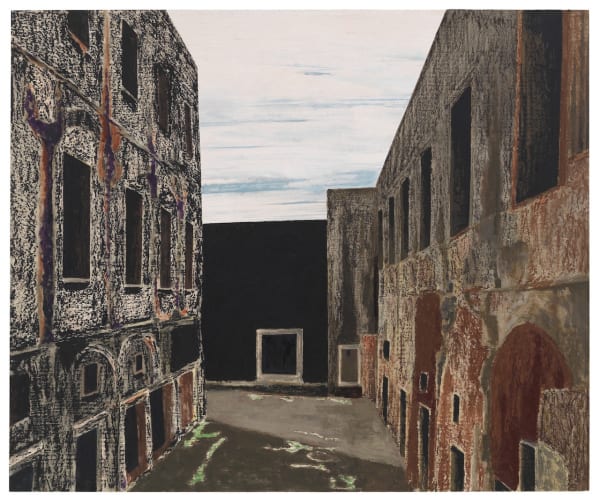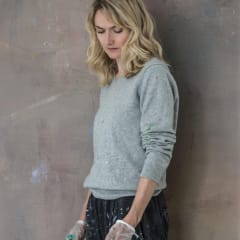Binnenshuis Group Show
Maaike Schoorel, Mamma Andersson and Louis Thevenet.
Mendes Wood DM has been invited to collaborate with Museum Dhondt-Dhaenens for the 7th edition of the Biennial of Painting, by presenting an exhibition in its townhouse gallery in the Sablon. The Biennial’s theme is Binnenskamers, or Inner Spaces, which has been loosely interpreted to include interior spaces and studios, but also a psychological state of introspection and the intimate realm of the imagination. On the suggestion of the artist Maaike Schoorel (b. 1973 in Santpoort, The Netherlands. Lives and works in Amsterdam), the gallery is taking part by presenting its own exhibition Binnenshuis, which translates to Inside the House, or Interiors. The Mendes Wood DM space is a former townhouse-turned-gallery, and many of the original architectural features are on display to remind visitors of this, so this presentation felt like a natural extension of the Biennial. A historical painting of an interior space by Louis Thevenet (b. 1874 in Bruges, Belgium, d. 1930 in Halle, Belgium) will be on display alongside works by Mamma Andersson (b. 1962 in Luleå, Sweden. Lives and works in Stockholm) and a selection of new paintings by Maaike Schoorel.
The historical tradition of Still Life and Interiors is integral to Flemish and Dutch art history, and some of the most celebrated and recognized works of this genre belong to artists from this part of the world, including Johannes Vermeer, Willem Claesz Heda and Pieter De Hoogh, to name but a few. In this vein, Binnenshuis opens with the Bruges-born artist Louis Thevenet’s painting De keuken (1924), generously loaned from the Museum Dhondt-Dhaenens.
Works from the genre of Still Life and Interiors often appear to the untrained eye as being “merely” paintings of rooms and simple objects, but appearances can be deceptive. Painters throughout the centuries have made an art of hiding coded messages about life, love and death in the arrangement of objects on a table, or in the selection of flowers in a vase, while depictions of rooms (with or without people) were often understood as allegories of complex states of mind that eventually became expressed through the language of 20th-century abstraction and even conceptual art.
Carrying on this conversation and bringing it into the 21st century are the works of two artists, Maaike Schoorel, Mamma Andersson, that will enter into a dialogue with the work of Thevenet and expand on these ideas with a bold new visual language, helpings us reinterpret and push the boundaries of what Binnenskamers, or Inner Space, is and can be.
Schoorel takes the idea of Still Life and subverts it, forcing viewers to combine their eyesight with their imaginative capabilities to decode the often mundane subjects of her work. At first, the titles of her paintings, such as Geel stekje (Pelargonium), Tulpen en Kauwgum (Tulips and Chewing Gum) and Wijnglas met Tandenstokers (Wineglass with Toothpicks), appear to be deceptive, for what initially meets the eye is an abstract melee of shapeless colors. But look closer and you will find that those very subjects materialize almost imperceptibly before your eyes, simmering up to the surface of the canvas, layer upon layer, until they stand out so clearly that it’s hard to understand how they didn’t appear so obviously at first glance.
Andersson’s work, on the other hand, takes us in a very different direction, along the lines of the Nordic painting tradition of Edvard Munch. Whether her paintings are of interiors or of landscapes, it is almost impossible to escape the uncanny feeling of metaphor that exudes from her canvases, that a depiction of the outside world is actually a mirror into the inner workings of the soul. Mood, atmosphere, psychological states, viewers have used any or all of these words when trying to describe something imperceptible, and yet wholly palpable that Andersson so masterfully communicates about her own inner world.
When the poet Alfred Lord Tennyson composed the poem The Palace of Art, a vast and articulate metaphor for the inner workings of the artist and of creative inspiration, it is perhaps no coincidence that he visualized the mindscape as architecture, as gilded arches, corridors, rooms, flowered gardens and cloisters, in which his muse could wander freely – a fitting visual image of how painters create the works that make our minds soar so high.
Maaike Schoorel's project for the 7th edition of the Biennial of Painting is possible thanks to the generous support of the Mondriaan Fonds.
Special thanks to Carolien Barkman, garden designer.








